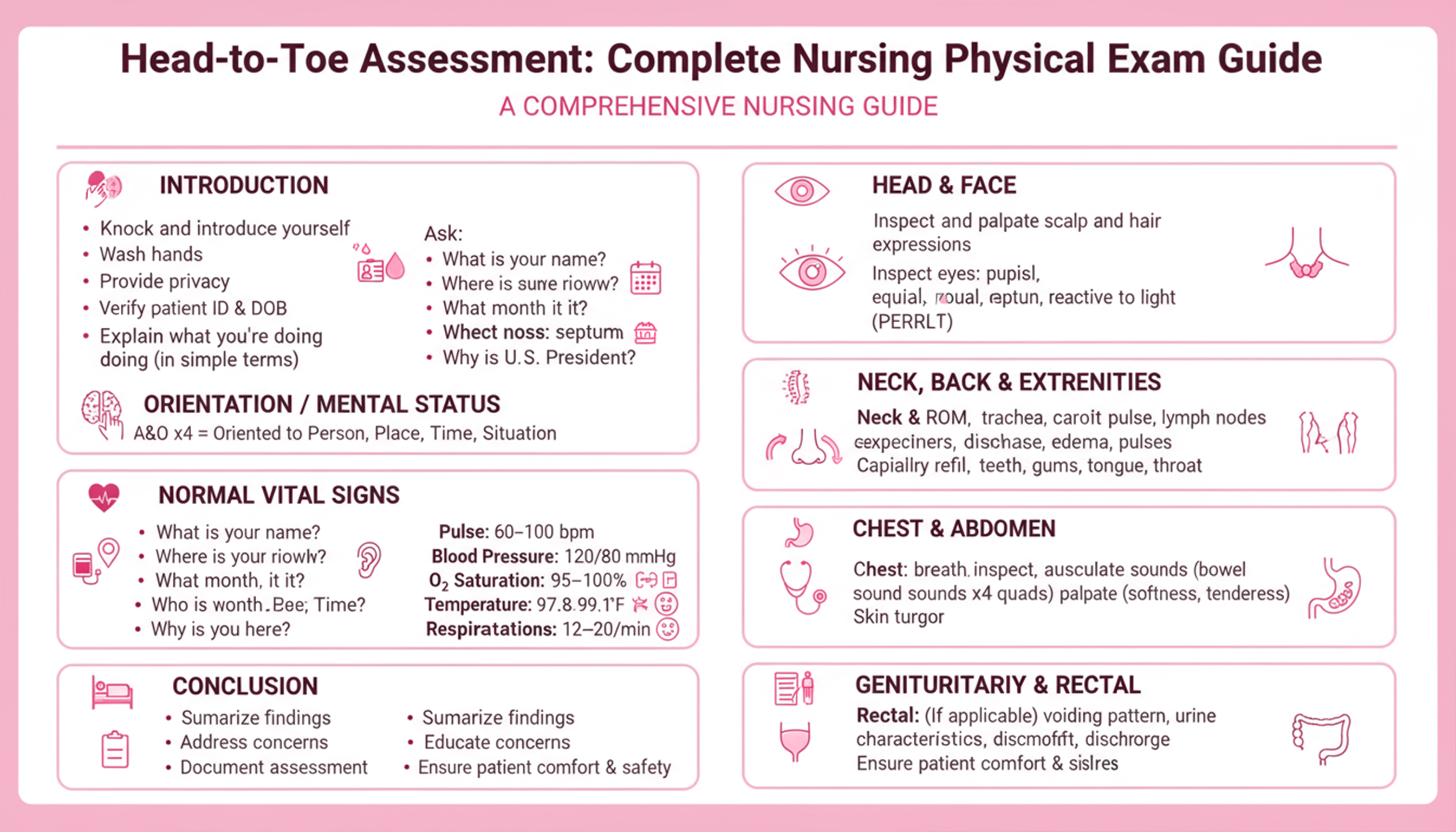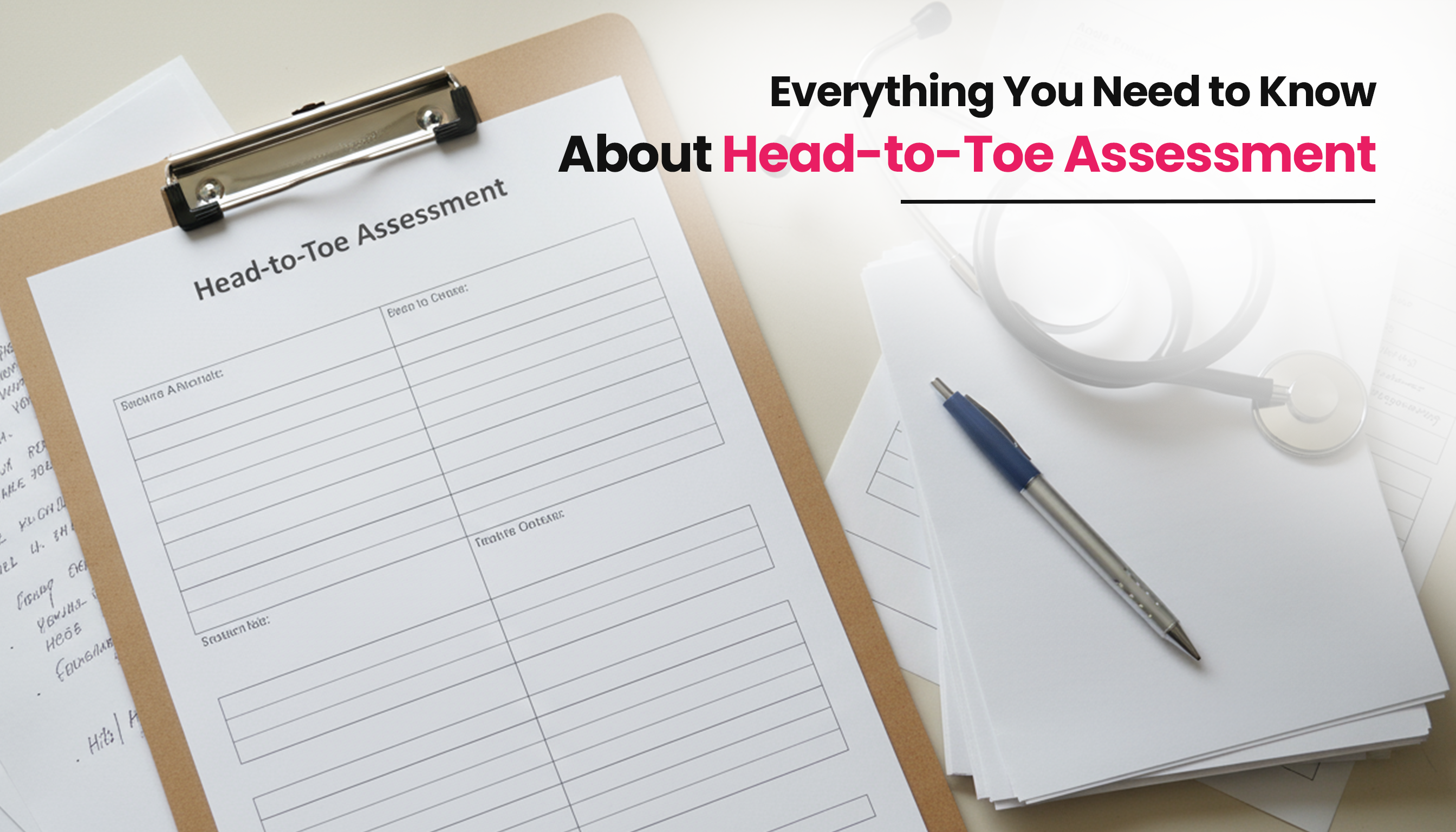A patient’s health story is written all over their body and it is the nurses’ duty to read it, from subtle changes in skin color to tiny shifts in breathing. Nurses’ duty is to notice these small changes quickly and prevent them from turning into a big problem. But how can you do that? Performing a Head-to-Toe Physical Assessment is the ultimate way to uncover these clues. It is a systematic approach used by nurses that allows them to evaluate patients thoroughly. And here it is, how you can do it like a pro! Before we start signing up and discovering high-paying travel nursing jobs with SkillGigs.
What is a head-to-toe physical assessment?
It is a systematic approach that allows nurses to evaluate their patient’s overall health thoroughly. This technique is performed by doctors, nurses and other healthcare professionals to identify the problem early. The purpose of a head-to-toe assessment is as follows:
- Detect any health issues or abnormalities early.
- Provide a baseline for patient’s condition for future assessment.
- To assist in planning and evaluating care.
- Improve patient safety by identifying potential risks early.
Why is head-to-toe assessment important?
- It helps with early detection of health issues.
- Formas a baseline for future assessments.
- Encourage holistic care.
Step-by-step head-to-toe assessment
Here is the detailed step-by-step head-to-toe assessment in nursing.
Preparation before assessment
Preparation is the first step before you start a head-to-toe physical assessment.
Gather tools:
- Stethoscope
- Thermometer
- Gloves
- Blood pressure cuff
- Tongue depressor
- Pulse oximeter
- Penlight
- Watch with second hand
- Wound Measurement Tool
Review the patient’s medical history:
Before you start a head-to-toe physical assessment, it is important to review the patient’s medical history as it will help you give the overall picture of the patient’s health. This will also help you give a baseline so that you can compare the current findings with previous data.
Wash your hands and wear gloves:
This is the vital step before you start a head-to-toe assessment, as it will ensure patient safety and prevent infection.
Explain the procedure:
The next important step before starting a head-to-toe assessment is to explain the procedure to the patient. This helps in getting their consent, builds trust, and respects patient rights.
Ensure privacy and comfort:
Ensure the privacy and comfort of the patient by closing curtains or doors. Creating such an environment ensures patient privacy and they can relax, which will help with a more accurate and thorough assessment.
Greet and introduce yourself:
- Knock before entering.
- Greet and ask how the patient wants to be addressed.
- Introduce yourself.
- Listen actively.

Head-to-toe assessment checklist
Initial assessment (subjective assessment)
As soon as you walk into the room you see the patient. Everything you notice is the initial assessment (subjective assessment) of the patient. Things you can notice are as follows:
- Overall appearance of the patient such as hygiene and grooming.
- Is the patient alert and responsive?
- Observe patients’ body posture and mobility.
- Notice signs of distress such as pain, labored breathing, or discomfort.
Vital signs (objective assessment):
Collect the objective data of the patient such as:
- Temperature
- Respirations
- Pulse
- Blood pressure
- Oxygen saturation
Neurological System Assessment:
- Level of consciousness
- Pupil response
- Speech and language
- Sensory function
- Motor function
- reflexes
Head and Face Assessment:
- Scalp hair skull: Inspect for lesions, bumps, etc.
- Face: Assess facial symmetry and skin color
- Eyes: Check pupil size, movement, and reaction to light.
- Ears: Examine for auditory function.
- Nose: Inspect patency, discharge, and symmetry.
- Mouth and throat: Assess teeth, tongues, gums, and tonsils.
Neck Assessment:
- Look for swelling, lumps, infection or thyroid issues or any other medical problem.
- Gently feel the sides of the neck for lymph nodes and trachea.
- Check range of motion by asking patients to move their neck up, down and side to see for any pain or stiffness.
- Lightly feel the carotid artery on each side of the neck, one at a time.
Respiratory System Assessment:
- Inspection: Ask the patient to breathe and inspect the chest for shape and movement.
- Palpation: Palpate the chest for tenderness and abnormal masses.
- Percussion: Lightly tap on your chest with your fingers and listen for a sound. The hollow, clear sound means everything is normal.
- Auscultation: Use a stethoscope for breathing sounds placing it back, front and sides.
Cardiovascular System Assessment:
- Inspection: Look for abnormal chest movement, observe neck veins and skin color.
- Palpation: Feel the pulses in different areas such as the wrist, arm, and neck.
- Auscultation: Use a stethoscope to listen to heart sounds such as S1, S2, murmurs, rubs, and gallops.
- Peripheral edema: Check ankles, feet and sacrum by pressing them gently to see any swelling or pitting.
Gastrointestinal System Assessment:
- Inspection: Check the shape or contour of the abdomen. Make sure both sides are symmetrical and also look for any scars, bruises or rashes.
- Palpation: Gently press the abdomen and check for tenderness, mass (lumps), pain or organ enlargement.
- Percussion: Gentle tap on abdomen and listen for hollow sound (tympany) or dull sound.
- Auscultation: With the help of a stethoscope, listen to bowel sounds in all four quadrants of the abdomen.
- Check for hernias and distention.
Genitourinary / Reproductive System Assessment:
- Check the color and quantity of the urine of patient and note its color, odor, and clarity.
- Inspect external genitalia for redness, sores, swelling, or any other abnormalities.
- Ask the patient if they have painful urination (dysuria), urgency, frequent urination, etc.
Musculoskeletal System Assessment:
- Inspection: Look for patients’ overall body posture. Notice any deformities, swelling or abnormalities.
- Palpation: Feel the joints and muscles for swelling or tenderness.
- Range of motion (ROM): Ask the patient to move their joints and check for active ROM and passive ROM.
- Check strength: Ask the patient to push or pull against the resistance to check the arm and leg strength.
- Gait and balance: Observe the gait and balance of the patient by asking them to walk and turn.
Skin, Hair, and Nails:
Check the following of the patient during the head-to-toe assessment:
- Skin: Look for color (pale, red, bluish tones), moisture (dry, sweaty), temperature (cool or warm), turgor (gently pinching to check if it turns back to normal quickly), lesions, rashes or bruising.
- Hair: Examine the texture of the hair whether they are dry, oily, or brittle. Also check for distribution of hair and the scalp for dryness, lesions, flaking, etc.
- Nails: To check nails, look for Color, capillary refill, clubbing, and brittleness.
Final steps of head-to-toe assessment:
- Documents your findings accurately and correctly without missing any of this.
- Report the abnormal finding to the provider.
- Clean and ensure patient comfort after the assessment.
Tips for successful head-to-toe assessment for nurses:
- Use the head-to-toe assessment flow consistently.
- Be observant and check for minor abnormalities.
- Communicate with patients and colleagues about the findings.
- Always maintain infection-controlled standards.
- Prioritize comfort and ensure the safety of the patient.
How often are head-to-toe assessments performed?
The frequency of head-to-toe assessment depends on the patient condition, but it’s performed during routine checkups, upon admission and when there is change in patient’s condition.
What are the methods or techniques used during a head-to-toe physical assessment?
- Inspection: Observing and looking at the patient carefully.
- Palpation: Feeling or examining the patient with hands to look for abnormalities.
- Percussion: Tapping to assess the underlying structures of the patient to look for any abnormalities.
- Auscultation: Listening to the sounds of the lungs, heart, and abdomen by using a stethoscope.
Conclusion
Head-to-toe physical assessment is a vital skill that every nurse and health care provider should master. It is more than just a routine check as it allows the nurses to understand the overall health of the patient. Head-to-toe assessment is a systematic approach that involves techniques such as inspection, palpation, percussion, and auscultation to check the overall health of the patient. It is important for every nurse to master the head-to-toe assessment to build trust with patients and ensure their safety.
Are you a nurse who is looking to level up their nursing skills? Join SkillGigs now and explore top high paying travel nursing jobs.







